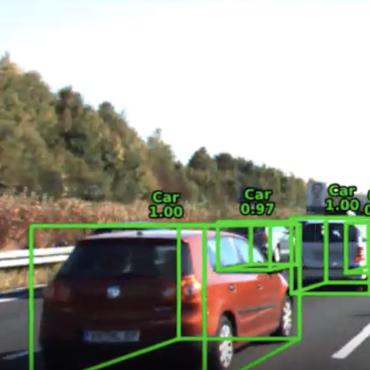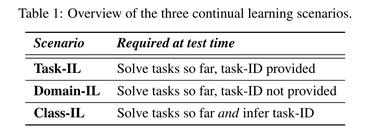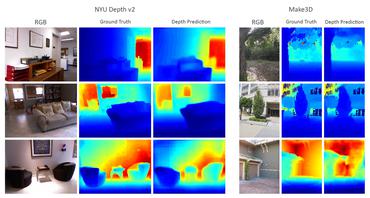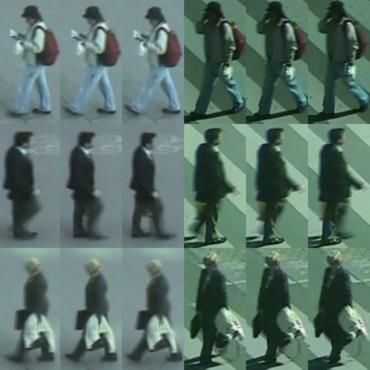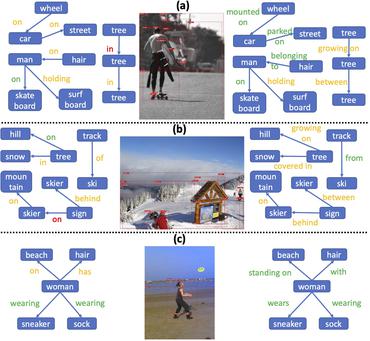Search Results for author: Jianqiang Huang
Found 64 papers, 30 papers with code
Momentum Batch Normalization for Deep Learning with Small Batch Size
no code implementations • ECCV 2020 • Hongwei Yong, Jianqiang Huang, Deyu Meng, Xian-Sheng Hua, Lei Zhang
To make a deeper understanding of BN, in this work we prove that BN actually introduces a certain level of noise into the sample mean and variance during the training process, while the noise level depends only on the batch size.
BERP: A Blind Estimator of Room Acoustic and Physical Parameters for Single-Channel Noisy Speech Signals
1 code implementation • 7 May 2024 • Lijun Wang, Yixian Lu, Ziyan Gao, Kai Li, Jianqiang Huang, Yuntao Kong, Shogo Okada
On the other hand, in this paper, we propose a novel universal blind estimation framework called the blind estimator of room acoustical and physical parameters (BERP), by introducing a new stochastic room impulse response (RIR) model, namely, the sparse stochastic impulse response (SSIR) model, and endowing the BERP with a unified encoder and multiple separate predictors to estimate RPPs and SSIR parameters in parallel.
ARFA: An Asymmetric Receptive Field Autoencoder Model for Spatiotemporal Prediction
no code implementations • 1 Sep 2023 • Wenxuan Zhang, Xuechao Zou, Li Wu, Xiaoying Wang, Jianqiang Huang, Junliang Xing
Additionally, we construct the RainBench, a large-scale radar echo dataset for precipitation prediction, to address the scarcity of meteorological data in the domain.
Structural and Statistical Texture Knowledge Distillation for Semantic Segmentation
no code implementations • CVPR 2022 • Deyi Ji, Haoran Wang, Mingyuan Tao, Jianqiang Huang, Xian-Sheng Hua, Hongtao Lu
Existing knowledge distillation works for semantic segmentation mainly focus on transferring high-level contextual knowledge from teacher to student.
Attention-based Class Activation Diffusion for Weakly-Supervised Semantic Segmentation
no code implementations • 20 Nov 2022 • Jianqiang Huang, Jian Wang, Qianru Sun, Hanwang Zhang
An intuitive solution is ``coupling'' the CAM with the long-range attention matrix of visual transformers (ViT) We find that the direct ``coupling'', e. g., pixel-wise multiplication of attention and activation, achieves a more global coverage (on the foreground), but unfortunately goes with a great increase of false positives, i. e., background pixels are mistakenly included.
 Weakly supervised Semantic Segmentation
Weakly supervised Semantic Segmentation
 Weakly-Supervised Semantic Segmentation
Weakly-Supervised Semantic Segmentation
On Mitigating Hard Clusters for Face Clustering
1 code implementation • 25 Jul 2022 • Yingjie Chen, Huasong Zhong, Chong Chen, Chen Shen, Jianqiang Huang, Tao Wang, Yun Liang, Qianru Sun
Face clustering is a promising way to scale up face recognition systems using large-scale unlabeled face images.
Rethinking IoU-based Optimization for Single-stage 3D Object Detection
1 code implementation • 19 Jul 2022 • Hualian Sheng, Sijia Cai, Na Zhao, Bing Deng, Jianqiang Huang, Xian-Sheng Hua, Min-Jian Zhao, Gim Hee Lee
Since Intersection-over-Union (IoU) based optimization maintains the consistency of the final IoU prediction metric and losses, it has been widely used in both regression and classification branches of single-stage 2D object detectors.
Spatial Likelihood Voting with Self-Knowledge Distillation for Weakly Supervised Object Detection
no code implementations • 14 Apr 2022 • Ze Chen, Zhihang Fu, Jianqiang Huang, Mingyuan Tao, Rongxin Jiang, Xiang Tian, Yaowu Chen, Xian-Sheng Hua
The likelihood maps generated by the SLV module are used to supervise the feature learning of the backbone network, encouraging the network to attend to wider and more diverse areas of the image.
Online Convolutional Re-parameterization
1 code implementation • CVPR 2022 • Mu Hu, Junyi Feng, Jiashen Hua, Baisheng Lai, Jianqiang Huang, Xiaojin Gong, Xiansheng Hua
Structural re-parameterization has drawn increasing attention in various computer vision tasks.
Homography Loss for Monocular 3D Object Detection
1 code implementation • CVPR 2022 • Jiaqi Gu, Bojian Wu, Lubin Fan, Jianqiang Huang, Shen Cao, Zhiyu Xiang, Xian-Sheng Hua
Monocular 3D object detection is an essential task in autonomous driving.
Dynamic Supervisor for Cross-dataset Object Detection
no code implementations • 1 Apr 2022 • Ze Chen, Zhihang Fu, Jianqiang Huang, Mingyuan Tao, Shengyu Li, Rongxin Jiang, Xiang Tian, Yaowu Chen, Xian-Sheng Hua
The application of cross-dataset training in object detection tasks is complicated because the inconsistency in the category range across datasets transforms fully supervised learning into semi-supervised learning.
Continual Learning for CTR Prediction: A Hybrid Approach
no code implementations • 18 Jan 2022 • Ke Hu, Yi Qi, Jianqiang Huang, Jia Cheng, Jun Lei
To address this problem, we formulate CTR prediction as a continual learning task and propose COLF, a hybrid COntinual Learning Framework for CTR prediction, which has a memory-based modular architecture that is designed to adapt, learn and give predictions continuously when faced with non-stationary drifting click data streams.
MPC: Multi-View Probabilistic Clustering
no code implementations • CVPR 2022 • Junjie Liu, Junlong Liu, Shaotian Yan, Rongxin Jiang, Xiang Tian, Boxuan Gu, Yaowu Chen, Chen Shen, Jianqiang Huang
Despite the promising progress having been made, the two challenges of multi-view clustering (MVC) are still waiting for better solutions: i) Most existing methods are either not qualified or require additional steps for incomplete multi-view clustering and ii) noise or outliers might significantly degrade the overall clustering performance.
Meta Convolutional Neural Networks for Single Domain Generalization
no code implementations • CVPR 2022 • Chaoqun Wan, Xu Shen, Yonggang Zhang, Zhiheng Yin, Xinmei Tian, Feng Gao, Jianqiang Huang, Xian-Sheng Hua
Taking meta features as reference, we propose compositional operations to eliminate irrelevant features of local convolutional features by an addressing process and then to reformulate the convolutional feature maps as a composition of related meta features.
 Ranked #4 on
Single-Source Domain Generalization
on Digits-five
Ranked #4 on
Single-Source Domain Generalization
on Digits-five
Balanced and Hierarchical Relation Learning for One-Shot Object Detection
1 code implementation • CVPR 2022 • Hanqing Yang, Sijia Cai, Hualian Sheng, Bing Deng, Jianqiang Huang, Xian-Sheng Hua, Yong Tang, Yu Zhang
In this paper, we introduce the balanced and hierarchical learning for our detector.
Deconfounded Visual Grounding
no code implementations • 31 Dec 2021 • Jianqiang Huang, Yu Qin, Jiaxin Qi, Qianru Sun, Hanwang Zhang
We focus on the confounding bias between language and location in the visual grounding pipeline, where we find that the bias is the major visual reasoning bottleneck.
AutoHEnsGNN: Winning Solution to AutoGraph Challenge for KDD Cup 2020
1 code implementation • 25 Nov 2021 • Jin Xu, Mingjian Chen, Jianqiang Huang, Xingyuan Tang, Ke Hu, Jian Li, Jia Cheng, Jun Lei
Graph Neural Networks (GNNs) have become increasingly popular and achieved impressive results in many graph-based applications.
Meta Clustering Learning for Large-scale Unsupervised Person Re-identification
no code implementations • 19 Nov 2021 • Xin Jin, Tianyu He, Xu Shen, Tongliang Liu, Xinchao Wang, Jianqiang Huang, Zhibo Chen, Xian-Sheng Hua
Unsupervised Person Re-identification (U-ReID) with pseudo labeling recently reaches a competitive performance compared to fully-supervised ReID methods based on modern clustering algorithms.
Self-Supervised Learning Disentangled Group Representation as Feature
1 code implementation • NeurIPS 2021 • Tan Wang, Zhongqi Yue, Jianqiang Huang, Qianru Sun, Hanwang Zhang
A good visual representation is an inference map from observations (images) to features (vectors) that faithfully reflects the hidden modularized generative factors (semantics).
Density-Based Clustering with Kernel Diffusion
no code implementations • 11 Oct 2021 • Chao Zheng, Yingjie Chen, Chong Chen, Jianqiang Huang, Xian-Sheng Hua
Finding a suitable density function is essential for density-based clustering algorithms such as DBSCAN and DPC.
Networked Time Series Prediction with Incomplete Data via Generative Adversarial Network
no code implementations • 5 Oct 2021 • Yichen Zhu, Bo Jiang, Haiming Jin, Mengtian Zhang, Feng Gao, Jianqiang Huang, Tao Lin, Xinbing Wang
An important task in such applications is to predict the future values of a NETS based on its historical values and the underlying graph.
Unleash the Potential of Adaptation Models via Dynamic Domain Labels
no code implementations • 29 Sep 2021 • Xin Jin, Tianyu He, Xu Shen, Songhua Wu, Tongliang Liu, Xinchao Wang, Jianqiang Huang, Zhibo Chen, Xian-Sheng Hua
In this paper, we propose an embarrassing simple yet highly effective adversarial domain adaptation (ADA) method for effectively training models for alignment.
AutoSmart: An Efficient and Automatic Machine Learning framework for Temporal Relational Data
1 code implementation • 9 Sep 2021 • Zhipeng Luo, Zhixing He, Jin Wang, Manqing Dong, Jianqiang Huang, Mingjian Chen, Bohang Zheng
Temporal relational data, perhaps the most commonly used data type in industrial machine learning applications, needs labor-intensive feature engineering and data analyzing for giving precise model predictions.
Improving 3D Object Detection with Channel-wise Transformer
1 code implementation • ICCV 2021 • Hualian Sheng, Sijia Cai, YuAn Liu, Bing Deng, Jianqiang Huang, Xian-Sheng Hua, Min-Jian Zhao
Though 3D object detection from point clouds has achieved rapid progress in recent years, the lack of flexible and high-performance proposal refinement remains a great hurdle for existing state-of-the-art two-stage detectors.
Aug3D-RPN: Improving Monocular 3D Object Detection by Synthetic Images with Virtual Depth
no code implementations • 28 Jul 2021 • Chenhang He, Jianqiang Huang, Xian-Sheng Hua, Lei Zhang
Current geometry-based monocular 3D object detection models can efficiently detect objects by leveraging perspective geometry, but their performance is limited due to the absence of accurate depth information.
Revisiting Knowledge Distillation: An Inheritance and Exploration Framework
1 code implementation • CVPR 2021 • Zhen Huang, Xu Shen, Jun Xing, Tongliang Liu, Xinmei Tian, Houqiang Li, Bing Deng, Jianqiang Huang, Xian-Sheng Hua
The inheritance part is learned with a similarity loss to transfer the existing learned knowledge from the teacher model to the student model, while the exploration part is encouraged to learn representations different from the inherited ones with a dis-similarity loss.
Partial Person Re-Identification With Part-Part Correspondence Learning
no code implementations • CVPR 2021 • Tianyu He, Xu Shen, Jianqiang Huang, Zhibo Chen, Xian-Sheng Hua
Driven by the success of deep learning, the last decade has seen rapid advances in person re-identification (re-ID).
Deep Position-wise Interaction Network for CTR Prediction
1 code implementation • 10 Jun 2021 • Jianqiang Huang, Ke Hu, Qingtao Tang, Mingjian Chen, Yi Qi, Jia Cheng, Jun Lei
Click-through rate (CTR) prediction plays an important role in online advertising and recommender systems.
Criterion-based Heterogeneous Collaborative Filtering for Multi-behavior Implicit Recommendation
1 code implementation • 25 May 2021 • Xiao Luo, Daqing Wu, Yiyang Gu, Chong Chen, Luchen Liu, Jinwen Ma, Ming Zhang, Minghua Deng, Jianqiang Huang, Xian-Sheng Hua
Besides, CHCF integrates criterion learning and user preference learning into a unified framework, which can be trained jointly for the interaction prediction of the target behavior.
Discriminative-Generative Dual Memory Video Anomaly Detection
no code implementations • 29 Apr 2021 • Xin Guo, Zhongming Jin, Chong Chen, Helei Nie, Jianqiang Huang, Deng Cai, Xiaofei He, Xiansheng Hua
In this paper, we propose a DiscRiminative-gEnerative duAl Memory (DREAM) anomaly detection model to take advantage of a few anomalies and solve data imbalance.
Graph Contrastive Clustering
1 code implementation • ICCV 2021 • Huasong Zhong, Jianlong Wu, Chong Chen, Jianqiang Huang, Minghua Deng, Liqiang Nie, Zhouchen Lin, Xian-Sheng Hua
On the other hand, a novel graph-based contrastive learning strategy is proposed to learn more compact clustering assignments.
Half-Real Half-Fake Distillation for Class-Incremental Semantic Segmentation
no code implementations • 2 Apr 2021 • Zilong Huang, Wentian Hao, Xinggang Wang, Mingyuan Tao, Jianqiang Huang, Wenyu Liu, Xian-Sheng Hua
Despite their success for semantic segmentation, convolutional neural networks are ill-equipped for incremental learning, \ie, adapting the original segmentation model as new classes are available but the initial training data is not retained.
 Class-Incremental Semantic Segmentation
Class-Incremental Semantic Segmentation
 Incremental Learning
+1
Incremental Learning
+1
Cloth-Changing Person Re-identification from A Single Image with Gait Prediction and Regularization
1 code implementation • CVPR 2022 • Xin Jin, Tianyu He, Kecheng Zheng, Zhiheng Yin, Xu Shen, Zhen Huang, Ruoyu Feng, Jianqiang Huang, Xian-Sheng Hua, Zhibo Chen
Specifically, we introduce Gait recognition as an auxiliary task to drive the Image ReID model to learn cloth-agnostic representations by leveraging personal unique and cloth-independent gait information, we name this framework as GI-ReID.
 Ranked #5 on
Person Re-Identification
on PRCC
Ranked #5 on
Person Re-Identification
on PRCC
 Cloth-Changing Person Re-Identification
Cloth-Changing Person Re-Identification
 Computational Efficiency
+1
Computational Efficiency
+1
The Blessings of Unlabeled Background in Untrimmed Videos
1 code implementation • CVPR 2021 • YuAn Liu, Jingyuan Chen, Zhenfang Chen, Bing Deng, Jianqiang Huang, Hanwang Zhang
The key challenge is how to distinguish the action of interest segments from the background, which is unlabelled even on the video-level.
 Weakly-supervised Temporal Action Localization
Weakly-supervised Temporal Action Localization
 Weakly Supervised Temporal Action Localization
Weakly Supervised Temporal Action Localization
Dense Interaction Learning for Video-based Person Re-identification
no code implementations • ICCV 2021 • Tianyu He, Xin Jin, Xu Shen, Jianqiang Huang, Zhibo Chen, Xian-Sheng Hua
The CNN encoder is responsible for efficiently extracting discriminative spatial features while the DI decoder is designed to densely model spatial-temporal inherent interaction across frames.
 Ranked #1 on
Person Re-Identification
on DukeMTMC-reID
Ranked #1 on
Person Re-Identification
on DukeMTMC-reID
Video Object Segmentation With Dynamic Memory Networks and Adaptive Object Alignment
1 code implementation • ICCV 2021 • Shuxian Liang, Xu Shen, Jianqiang Huang, Xian-Sheng Hua
In this paper, we propose a novel solution for object-matching based semi-supervised video object segmentation, where the target object masks in the first frame are provided.
3D Local Convolutional Neural Networks for Gait Recognition
1 code implementation • ICCV 2021 • Zhen Huang, Dixiu Xue, Xu Shen, Xinmei Tian, Houqiang Li, Jianqiang Huang, Xian-Sheng Hua
Second, different body parts possess different scales, and even the same part in different frames can appear at different locations and scales.
 Ranked #2 on
Gait Recognition
on OUMVLP
Ranked #2 on
Gait Recognition
on OUMVLP
VideoFlow: A Framework for Building Visual Analysis Pipelines
no code implementations • 1 Jan 2021 • Yue Wu, Jianqiang Huang, Jiangjie Zhen, Guokun Wang, Chen Shen, Chang Zhou, Xian-Sheng Hua
The past years have witnessed an explosion of deep learning frameworks like PyTorch and TensorFlow since the success of deep neural networks.
Camera-aware Proxies for Unsupervised Person Re-Identification
1 code implementation • 19 Dec 2020 • Menglin Wang, Baisheng Lai, Jianqiang Huang, Xiaojin Gong, Xian-Sheng Hua
These camera-aware proxies enable us to deal with large intra-ID variance and generate more reliable pseudo labels for learning.
Learning to Generate Content-Aware Dynamic Detectors
no code implementations • 8 Dec 2020 • Junyi Feng, Jiashen Hua, Baisheng Lai, Jianqiang Huang, Xi Li, Xian-Sheng Hua
To the best of our knowledge, our CADDet is the first work to introduce dynamic routing mechanism in object detection.
Spatio-Temporal Inception Graph Convolutional Networks for Skeleton-Based Action Recognition
1 code implementation • 26 Nov 2020 • Zhen Huang, Xu Shen, Xinmei Tian, Houqiang Li, Jianqiang Huang, Xian-Sheng Hua
The topology of the adjacency graph is a key factor for modeling the correlations of the input skeletons.
DCT-Mask: Discrete Cosine Transform Mask Representation for Instance Segmentation
1 code implementation • CVPR 2021 • Xing Shen, Jirui Yang, Chunbo Wei, Bing Deng, Jianqiang Huang, Xiansheng Hua, Xiaoliang Cheng, Kewei Liang
Generally, a low-resolution grid is not sufficient to capture the details, while a high-resolution grid dramatically increases the training complexity.
Tracklets Predicting Based Adaptive Graph Tracking
no code implementations • 18 Oct 2020 • Chaobing Shan, Chunbo Wei, Bing Deng, Jianqiang Huang, Xian-Sheng Hua, Xiaoliang Cheng, Kewei Liang
It re-extracts the features of the tracklets in the current frame based on motion predicting, which is the key to solve the problem of features inconsistent.
CIMON: Towards High-quality Hash Codes
no code implementations • 15 Oct 2020 • Xiao Luo, Daqing Wu, Zeyu Ma, Chong Chen, Minghua Deng, Jinwen Ma, Zhongming Jin, Jianqiang Huang, Xian-Sheng Hua
However, due to the inefficient representation ability of the pre-trained model, many false positives and negatives in local semantic similarity will be introduced and lead to error propagation during the hash code learning.
Long-Tailed Classification by Keeping the Good and Removing the Bad Momentum Causal Effect
2 code implementations • NeurIPS 2020 • Kaihua Tang, Jianqiang Huang, Hanwang Zhang
On one hand, it has a harmful causal effect that misleads the tail prediction biased towards the head.
 Ranked #36 on
Long-tail Learning
on CIFAR-10-LT (ρ=10)
Ranked #36 on
Long-tail Learning
on CIFAR-10-LT (ρ=10)
PCPL: Predicate-Correlation Perception Learning for Unbiased Scene Graph Generation
1 code implementation • 2 Sep 2020 • Shaotian Yan, Chen Shen, Zhongming Jin, Jianqiang Huang, Rongxin Jiang, Yaowu Chen, Xian-Sheng Hua
Today, scene graph generation(SGG) task is largely limited in realistic scenarios, mainly due to the extremely long-tailed bias of predicate annotation distribution.
 Ranked #4 on
Unbiased Scene Graph Generation
on Visual Genome
Ranked #4 on
Unbiased Scene Graph Generation
on Visual Genome
Apparel-invariant Feature Learning for Apparel-changed Person Re-identification
no code implementations • 14 Aug 2020 • Zhengxu Yu, Yilun Zhao, Bin Hong, Zhongming Jin, Jianqiang Huang, Deng Cai, Xiaofei He, Xian-Sheng Hua
Therefore, it is critical to learn an apparel-invariant person representation under cases like cloth changing or several persons wearing similar clothes.
Out-of-distribution Generalization via Partial Feature Decorrelation
no code implementations • 30 Jul 2020 • Xin Guo, Zhengxu Yu, Chao Xiang, Zhongming Jin, Jianqiang Huang, Deng Cai, Xiaofei He, Xian-Sheng Hua
Most deep-learning-based image classification methods assume that all samples are generated under an independent and identically distributed (IID) setting.
Joint Auction-Coalition Formation Framework for Communication-Efficient Federated Learning in UAV-Enabled Internet of Vehicles
no code implementations • 13 Jul 2020 • Jer Shyuan Ng, Wei Yang Bryan Lim, Hong-Ning Dai, Zehui Xiong, Jianqiang Huang, Dusit Niyato, Xian-Sheng Hua, Cyril Leung, Chunyan Miao
The simulation results show that the grand coalition, where all UAVs join a single coalition, is not always stable due to the profit-maximizing behavior of the UAVs.
Networking and Internet Architecture Signal Processing
Towards Federated Learning in UAV-Enabled Internet of Vehicles: A Multi-Dimensional Contract-Matching Approach
no code implementations • 8 Apr 2020 • Wei Yang Bryan Lim, Jianqiang Huang, Zehui Xiong, Jiawen Kang, Dusit Niyato, Xian-Sheng Hua, Cyril Leung, Chunyan Miao
Coupled with the rise of Deep Learning, the wealth of data and enhanced computation capabilities of Internet of Vehicles (IoV) components enable effective Artificial Intelligence (AI) based models to be built.
Signal Processing Networking and Internet Architecture
Gradient Centralization: A New Optimization Technique for Deep Neural Networks
7 code implementations • ECCV 2020 • Hongwei Yong, Jianqiang Huang, Xian-Sheng Hua, Lei Zhang
It has been shown that using the first and second order statistics (e. g., mean and variance) to perform Z-score standardization on network activations or weight vectors, such as batch normalization (BN) and weight standardization (WS), can improve the training performance.
A Survey on Deep Hashing Methods
no code implementations • 4 Mar 2020 • Xiao Luo, Haixin Wang, Daqing Wu, Chong Chen, Minghua Deng, Jianqiang Huang, Xian-Sheng Hua
Nearest neighbor search aims to obtain the samples in the database with the smallest distances from them to the queries, which is a basic task in a range of fields, including computer vision and data mining.
Unbiased Scene Graph Generation from Biased Training
6 code implementations • CVPR 2020 • Kaihua Tang, Yulei Niu, Jianqiang Huang, Jiaxin Shi, Hanwang Zhang
Today's scene graph generation (SGG) task is still far from practical, mainly due to the severe training bias, e. g., collapsing diverse "human walk on / sit on / lay on beach" into "human on beach".
 Ranked #3 on
Scene Graph Generation
on Visual Genome
Ranked #3 on
Scene Graph Generation
on Visual Genome
Visual Commonsense R-CNN
1 code implementation • CVPR 2020 • Tan Wang, Jianqiang Huang, Hanwang Zhang, Qianru Sun
We present a novel unsupervised feature representation learning method, Visual Commonsense Region-based Convolutional Neural Network (VC R-CNN), to serve as an improved visual region encoder for high-level tasks such as captioning and VQA.
 Ranked #23 on
Image Captioning
on COCO Captions
Ranked #23 on
Image Captioning
on COCO Captions
Towards Precise Intra-camera Supervised Person Re-identification
no code implementations • 12 Feb 2020 • Menglin Wang, Baisheng Lai, Haokun Chen, Jianqiang Huang, Xiaojin Gong, Xian-Sheng Hua
Our approach performs even comparable to state-of-the-art fully supervised methods in two of the datasets.
Two Causal Principles for Improving Visual Dialog
1 code implementation • CVPR 2020 • Jiaxin Qi, Yulei Niu, Jianqiang Huang, Hanwang Zhang
This paper unravels the design tricks adopted by us, the champion team MReaL-BDAI, for Visual Dialog Challenge 2019: two causal principles for improving Visual Dialog (VisDial).
Quantization Networks
1 code implementation • CVPR 2019 • Jiwei Yang, Xu Shen, Jun Xing, Xinmei Tian, Houqiang Li, Bing Deng, Jianqiang Huang, Xian-Sheng Hua
The proposed quantization function can be learned in a lossless and end-to-end manner and works for any weights and activations of neural networks in a simple and uniform way.
Neural News Recommendation with Heterogeneous User Behavior
no code implementations • IJCNLP 2019 • Chuhan Wu, Fangzhao Wu, Mingxiao An, Tao Qi, Jianqiang Huang, Yongfeng Huang, Xing Xie
In the user representation module, we propose an attentive multi-view learning framework to learn unified representations of users from their heterogeneous behaviors such as search queries, clicked news and browsed webpages.
Progressive Transfer Learning
1 code implementation • 7 Aug 2019 • Zhengxu Yu, Dong Shen, Zhongming Jin, Jianqiang Huang, Deng Cai, Xian-Sheng Hua
Model fine-tuning is a widely used transfer learning approach in person Re-identification (ReID) applications, which fine-tuning a pre-trained feature extraction model into the target scenario instead of training a model from scratch.
NPA: Neural News Recommendation with Personalized Attention
no code implementations • 12 Jul 2019 • Chuhan Wu, Fangzhao Wu, Mingxiao An, Jianqiang Huang, Yongfeng Huang, Xing Xie
Since different words and different news articles may have different informativeness for representing news and users, we propose to apply both word- and news-level attention mechanism to help our model attend to important words and news articles.
Neural News Recommendation with Attentive Multi-View Learning
5 code implementations • 12 Jul 2019 • Chuhan Wu, Fangzhao Wu, Mingxiao An, Jianqiang Huang, Yongfeng Huang, Xing Xie
In the user encoder we learn the representations of users based on their browsed news and apply attention mechanism to select informative news for user representation learning.
 Ranked #6 on
News Recommendation
on MIND
Ranked #6 on
News Recommendation
on MIND
Deep Active Learning for Video-based Person Re-identification
no code implementations • 14 Dec 2018 • Menglin Wang, Baisheng Lai, Zhongming Jin, Xiaojin Gong, Jianqiang Huang, Xian-Sheng Hua
With the gained annotations of the actively selected candidates, the tracklets' pesudo labels are updated by label merging and further used to re-train our re-ID model.
Dynamic Spatio-temporal Graph-based CNNs for Traffic Prediction
no code implementations • 5 Dec 2018 • Ken Chen, Fei Chen, Baisheng Lai, Zhongming Jin, Yong liu, Kai Li, Long Wei, Pengfei Wang, Yandong Tang, Jianqiang Huang, Xian-Sheng Hua
To capture the graph dynamics, we use the graph prediction stream to predict the dynamic graph structures, and the predicted structures are fed into the flow prediction stream.
Homocentric Hypersphere Feature Embedding for Person Re-identification
no code implementations • 24 Apr 2018 • Wangmeng Xiang, Jianqiang Huang, Xianbiao Qi, Xian-Sheng Hua, Lei Zhang
Person re-identification (Person ReID) is a challenging task due to the large variations in camera viewpoint, lighting, resolution, and human pose.

